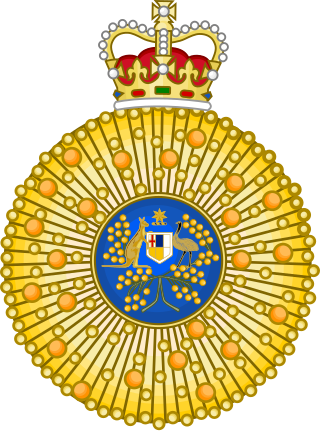In the United Kingdom and the British Overseas Territories, personal bravery, achievement, or service are rewarded with honours. The honours system consists of three types of award:

The Order of Australia is an Australian honour that recognises Australian citizens and other persons for outstanding achievement and service. It was established on 14 February 1975 by Elizabeth II, Queen of Australia, on the advice of then prime minister Gough Whitlam. Before the establishment of the order, Australians could receive British honours, which continued to be issued in parallel until 1992.

The Most Excellent Order of the British Empire is a British order of chivalry, rewarding contributions to the arts and sciences, work with charitable and welfare organisations, and public service outside the civil service. It comprises five classes of awards across both civil and military divisions, the most senior two of which make the recipient either a knight if male or a dame if female. There is also the related British Empire Medal, whose recipients are affiliated with, but not members of, the order.
Sir is a formal honorific address in English for men, derived from Sire in the High Middle Ages. Both are derived from the old French "Sieur" (Lord), brought to England by the French-speaking Normans, and which now exist in French only as part of "Monsieur", with the equivalent "My Lord" in English.

The Most Honourable Order of the Bath is a British order of chivalry founded by King George I on 18 May 1725. Recipients of the Order are usually senior military officers or senior civil servants, and the monarch awards it on the advice of His Majesty's Government. The name derives from an elaborate medieval ceremony for preparing a candidate to receive his knighthood, of which ritual bathing was an element. While not all knights went through such an elaborate ceremony, knights so created were known as "knights of the Bath".

The Order of Merit is an order of merit for the Commonwealth realms, recognising distinguished service in the armed forces, science, art, literature, or the promotion of culture. Established in 1902 by Edward VII, admission into the order remains the personal gift of its Sovereign—currently Edward VII's great-great-grandson Charles III—and is restricted to a maximum of 24 living recipients from the Commonwealth realms, plus honorary members. While all members are awarded the right to use the post-nominal letters OM and wear the badge of the order, the Order of Merit's precedence among other honours differs between countries.

The New Zealand royal honours system, a system of orders, decorations and medals, recognises achievements of, or service by, New Zealanders or others in connection with New Zealand. Until 1975, New Zealand used the British honours system. Since then the country has introduced a number of uniquely New Zealand honours, and as of 2021, only the dynastic British honours continue in active use in New Zealand, with the exception of the Order of the Companions of Honour.

The Most Distinguished Order of Saint Michael and Saint George is a British order of chivalry founded on 28 April 1818 by George, Prince of Wales, while he was acting as prince regent for his father, King George III. It is named in honour of two military saints, Michael and George.

The Royal Victorian Order is a dynastic order of knighthood established in 1896 by Queen Victoria. It recognises distinguished personal service to the monarch, members of the royal family, or to any viceroy or senior representative of the monarch. The present monarch, King Charles III, is the sovereign of the order. The order's motto is Victoria. The order's official day is 20 June. The order's chapel is the Savoy Chapel in London.

The King's Service Order, established by royal warrant of Queen Elizabeth II on 13 March 1975, is used to recognise "valuable voluntary service to the community or meritorious and faithful services to the Crown or similar services within the public sector, whether in elected or appointed office". This order was created after a review of New Zealand's honours system in 1974. The King's Service Order replaced the Imperial Service Order in New Zealand.
The Canadian titles debate originated with the presentation to the House of Commons of Canada of the Nickle Resolution in 1917. This resolution marked the earliest attempt to establish a federal government policy requesting the sovereign, in the right of the United Kingdom, not to grant knighthoods, baronetcies, and peerages to Canadians and set the precedent for later policies restricting Canadians from accepting titles from foreign countries. Dissatisfaction with the British honours system led to the gradual creation of a separate system for Canada.

Sir Anand Satyanand, is a New Zealand former lawyer, judge and ombudsman who served as the 19th Governor-General of New Zealand from 2006 to 2011.
The order of wear for decorations and awards within New Zealand's honours system is published by the Department of the Prime Minister and Cabinet.
This is an incomplete list of Australians who have been appointed a knight or a dame, being entitled to be known as "sir" or "dame" respectively. It includes living Australian knights and dames as well as dead appointees. The list excludes Australian baronets; they have the title sir, but are not knights per se.

The Italian honours system is a means to reward achievements or service to the Italian Republic, formerly the Kingdom of Italy, including the Italian Social Republic.
The 2009 Special Honours in New Zealand were announced in August 2009 as a result of the reinstatement of the appellations of "Sir" and "Dame" to the New Zealand Royal Honours System by passing Special Regulation 2009/90 Additional Statutes of The New Zealand Order of Merit, a legally binding regulation with the force of law in New Zealand.
The following is a list of living New Zealanders who have been appointed dames or knights.
The 2021 Special Honours in New Zealand were three special honours lists, published in New Zealand on 9 August, 28 September, and 21 December 2021.
































